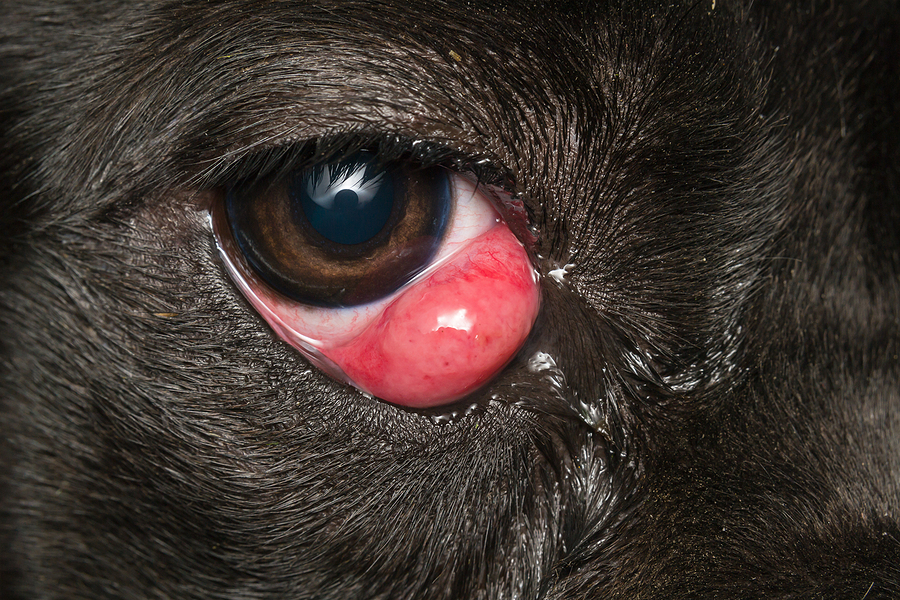Have you ever noticed a small red lump of tissue in the corner of your dog’s eye? It looks unsightly and may even prevent someone from wanting to choose that dog. But the good news is it’s curable and preventable.
What is Cherry Eye in Dogs
This is a condition called cherry eye and it is actually the lymph node off of the third eyelid causing the issue. Like all lymph nodes, when irritated it becomes swollen and enlarged. On the third eyelid this lymph node is normally behind the lid in a pouch. When swollen it can pop out of the pouch, turn outward and become enlarged causing permanent cherry eye tissue.
Early Stage Cherry Eye in Dogs
Any irritation or infection of the eye can start the issue that will eventually lead to cherry eye in dogs. In older animals, allergens can be the cause, but in puppies it is often just eye irritation left untreated.
Cherry Eye in Dogs Treatment and Prevention
The best way to prevent canine cherry eye is to treat eye irritation right away when it happens. Doing this lets the irritated lymph node go down and prevents it from becoming permanently swollen. Drops can be used; however, antibiotic eye ointments or gels have a longer-lasting effect in eye tissue and are the most common treatment. If no ulcer is seen on the cornea, an ointment with hydrocortisone is best at taking the swelling down.
When we first see the irritated swelling in puppies it’s important to quickly treat the eye with Vetericyn® Plus Ophthalmic Gel. Doing this helps the swelling go down and eye goes back to normal.
Canine cherry eye is often a problem that appears post weaning. Treating the eye to soothe irritation twice a week at six and seven weeks of age will usually prevent the issue.
How Seasons Play a Role
The most common times when cherry eye happens is in the fall when heating units dry out the air and during spring pollen season. The key is treating the irritated eye early. Ointment and gels do that job best!
Cherry Eye Surgery
Surgical intervention is not preferred but may be necessary. Consult your veterinarian if you have a case where you think surgery for cherry eye may be necessary. Cherry eye poses little issue for the puppy or adult dog but is unsightly. If you are able to treat the irritated eye early and decrease the swelling of the third eyelid, most dogs can avoid surgery all together and that is what we all prefer.
If you have more questions on cherry eye in dogs, call us at 800.786.4751.
LEARN MORE:
Eye Care for Dogs and Cats
How can I treat my dogs eye problems? If your dog or cat has eye problems, it's usually because of bacteria and irritation. Learn how to keep your pet's eyes healthy.
Dry Eye in Dogs: Canine Keratoconjunctivitis sicca
Is dry eye in dogs serious? Dry Eye in dogs, also known as canine Keratoconjunctivitis sicca (KCS), is caused by inadequate tear production. Learn dog dry eye causes, symptoms, diagnosis and how to treat dry eye in a dog.
Vet Minute: Neonatal Ophthalmia- Puppy and Kitten Eye Infections
Why is my newborn puppy eye swollen? Puppy swollen eyes or kitten puffy eyes, need immediate attention. Learn about puppy and kitten eye infections, also known as neonatal ophthalmia.
Puppy Swollen Eyes & Newborn Puppy Eye Infection
Signs of puppy eye infections include a swollen eye or pus coming out of the corner of the eye. Learn how to quickly treat eye infections in puppies.
Written by: Donald Bramlage, DVM
Donald Bramlage, Doctor of Veterinary Medicine, practiced veterinary medicine for 30+ years and is known for his work in managing parvovirus. He received his Doctor of Veterinary Medicine from Kansas State University in 1985. He served as Revival’s Director of Veterinary Services from 2011 until his retirement in 2019.